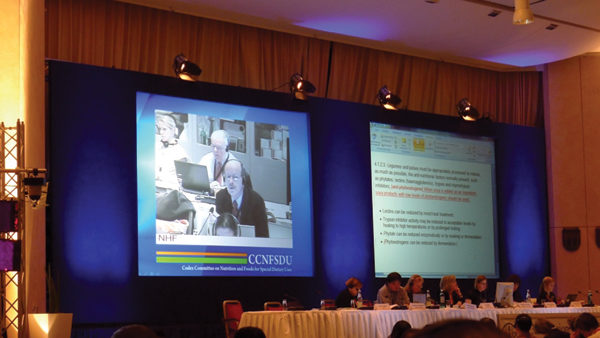Above: NHF delegate Scott Tips finally gets a chance to speak the following day after Codex Chairwoman ignores several NHF requests to take the floor on the issue of saturated fats.
The Conspiracy of Silence is not just limited to the political arena. At the 33rd session of the Codex Committee on Nutrition and Foods for Special Dietary Uses (CCNFSDU), which ended its week-long meeting on Friday, November 18, its new Chairwoman, Pia Noble, had a definite problem in allowing the International Non-Governmental Organizations (INGOs) such as the National Health Federation (NHF) to speak.
Kindred Spirits
Coming from the German Federal Ministry of Food, Agriculture and Consumer Protection (BMLEV), Dr. Noble, who succeeded to her Codex position upon the retirement of Dr. Rolf Grossklaus two years ago, finds kindred spirits in her fellow government bureaucratic delegates. They share the same delight in crafting people controls. But, INGOs? Those nuisances are just slowing down the adoption of Codex guidelines and standards. Okay, they can fill up the bleachers at the meetings because it looks good; but they absolutely must behave themselves.
Dr. Grossklaus, whom NHF had criticized over the long years, actually did the world a favor when he held back the Nutrient Reference Value (NRV) standard at the 2009 CCNFSDU meeting, at the insistence of NHF, India and Iraq. That standard would have dumbed down vitamin-and-mineral NRVs to absurdly low levels. Grossklaus could have allowed those standards to advance, over our stubborn objections; but he didn’t, and he is to be thanked for that. He also had no problem generally in recognizing all of the INGOs to take the floor and speak. In that respect, he was not much different than most of the other Committee chairmen and -women. He might have squabbled with the NHF delegate, but at least its view was often allowed to be expressed. Not so with Pia Noble.
The Threat
Acknowledged as being rather outspoken, NHF started off its participation in the meeting on Monday, November 14, with a bang, speaking out at every turn in favor of broadening the Terms of Reference (i.e., mandate) given to the Electronic Working Group (eWG) for establishing NRV standards for nutrients so as to include science other than just Food and Agriculture Organization (FAO)/World Health Organization (WHO) scientific findings. Most delegates defer to their science in adopting numbers to insert into such standards. NHF’s view is that when Codex considers adopting any standards, it should look far and wide at all pertinent science, whether it comes from FAO/WHO or not.
Amazingly, after all, NHF’s near solitary and obstinate opposition to the vitamin-and-mineral NRVs back in 2009 had killed their momentum on the path towards adoption. But for that opposition, they would, by now, have been well along the eight-step track to adoption by Codex. The 2010 Committee meeting in Santiago, Chile saw even more opposition and a request by the Committee for FAO/WHO to come up with a report on NRVs, which they did just in time for this November 2011 Committee meeting.
So, as I sat there on Monday and leafed through the rather impressive 39-page FAO/WHO report, and listened while the WHO representative presented the report and the Committee then discussed it, I suddenly realized that we were all here, spending time on this, because I had reacted so strongly and persistently two years ago. NHF had caused this. It felt good.
The CCNFSDU created an eWG charged with reporting to the Committee at next year’s meeting with its recommendations for NRVs for vitamins and minerals. The NHF will be part of this eWG. This means that—for a third year in a row—no dumbed-down vitamin-and-mineral NRVs were adopted at Codex.1
So Silence the Threat
Later, the Committee took up the issue of NRVs for Saturated Fatty Acids.2 Adhering to the outdated views first espoused by the makers of Crisco in 1911, when they wanted to shove butter and lard off grocery-store shelves in favor of their new-fangled invention, Crisco, most Codex delegates still think that saturated fats are the cause of heart attacks. That is why the Committee wanted to establish an NRV of no more than 10% of daily energy intake for this fat3 and push consumers towards a higher intake of the “safe” polyunsaturated fatty acids.
Such nonsense is often what passes for “science” at Codex these days, with no correlation to current research that anyone could pull off of Pub-Med within two minutes. The delegation of Malaysia, though, cannot be tarred with this tattered brush. Malaysia clearly and unequivocally stated its views that saturated fats had a role in the diet and were not correlated with the risk of coronary heart disease. The International Dairy Federation (IDF) supported this view and provided its own defense of saturated fats in a healthy diet.
NHF was given the floor to speak immediately after IDF. As I told the Committee during this one and only time that I was allowed to speak at the meeting on this issue, and in specific response to the Thai delegate’s mistaken remark that saturated fats were the cause of heart disease, “Actually, NHF disagrees. There is no convincing evidence that replacing Saturated Fatty Acids with Polyunsaturated Fatty Acids results in fewer heart attacks or less coronary heart disease. Does it show that cholesterol is lowered? Yes. But what it does not do is show that CHD is reduced. That is a myth and saturated fats have been unfairly demonized. There are any number of other factors that are more closely correlated with heart disease than cholesterol, factors such as homocysteine and C-Reactive protein levels.”
I continued, “By pushing consumers into using dietary PUFAs instead of saturated fats, more harm to health has resulted. PUFAs are notoriously unstable and go rancid very easily, generating free-radical damage to the body. NHF has researched this issue off and on for 50 years and I could provide at least 1,147 references showing that polyunsaturated fats are a major cause of the epidemic of obesity, type-2 diabetes, heart disease, stroke, cancer and various mental problems. On the other hand, saturated fats fulfill many important biological roles, and, not surprisingly, make up 54% of mother’s milk, while polyunsaturated fats are only a very-small 3%. So, to limit saturated-fat NRVs to 10% of energy intake is wrong.”
The WHO representative then took the floor to defend the cholesterol-causes-heart-attacks position, citing 30,900 years (!) of research on this subject proving the saturated fat-heart disease risk connection. These kinds of defenses are illogical through their insistence that since saturated fats “cause” high cholesterol levels, ergo, they must cause coronary heart disease. Such arguments—because that’s all they really are—invariably fail to account for the fact that calcification of the arteries, oxidized cholesterol versus cholesterol itself, and other health factors are the real culprits.
But I never got the chance to address this issue. I pushed my microphone button down and it started flashing, indicating that I had asked for the floor to speak and should have been in line to be recognized. I waited . . . and waited . . . and waited.
Meanwhile, the other delegates were all recognized to speak. Impressively enough, the Canadian delegate, Ms. Nora Lee, showed her open-mindedness by suggesting the Committee look into PUFAs, perhaps even establishing an NRV for them. No one really spoke out in support of this sensible Canadian position (except perhaps for a favorable but different and equally sensible comment by the U.S. delegate). I was eager to support Canada; and as the issue was hanging in the balance, there was yet a chance to influence the outcome. But the Chairwoman still ignored NHF. I looked down at NHF’s microphone button, which continued to flash incessantly, as I slowly twisted in the wind.
Finally, the Chairwoman peremptorily announced to the Committee at large that NHF was asking to be recognized but that she was not going to do it! She then moved on and stated that the Committee had adopted by consensus the NRV for Saturated Fatty Acids at 10% of daily energy intake.
The Solution
This has happened before, and I’ve found the best approach is the direct one. Speak with the Chairman or Chairwoman, and that’s what I did here, telling her that NHF deserved and expected to be recognized to speak. We were both polite, and I acknowledged that NHF had spoken at length before but still insisted that we had had additional matters to bring before the Committee and should have been allowed to do so. She said she understood. One member of our four-person NHF delegation, Caroline Knight, was there with me as a witness.4
The following day was better. NHF was again recognized; but the moment, of course, had passed. The Saturated Fatty Acid NRV will come up for debate at the next Codex Alimentarius Commission meeting in Rome, Italy, next July, and everyone can be sure that it will again be pounced upon there. So, this matter is hardly finished.
On a more positive and important note, the general, dumbed-down NRVs for vitamins and minerals was put off for yet another year as the FAO/WHO Report is considered by an eWG of which NHF will be part. This means that the next meeting of the Codex Committee on Nutrition and Foods for Special Dietary Uses, to be held in Germany in early December 2012, will be pivotal and perhaps w itness the climactic battle on this issue. Two weeks later, the ancient Mayan calendar stops, which some say means the end of the World. Maybe the Mayans were just predicting the result of the Codex meeting . . . but NHF will see about that. WF
itness the climactic battle on this issue. Two weeks later, the ancient Mayan calendar stops, which some say means the end of the World. Maybe the Mayans were just predicting the result of the Codex meeting . . . but NHF will see about that. WF
A graduate of the University of California at Berkeley Law School, Scott C. Tips currently practices internationally, emphasizing Food-and-Drug law, business law and business litigation, trade practice, and international corporate formation and management. He has been involved in the nutrition field for more than three decades and may be reached at (415) 244-1813 or by e-mail at scott@rivieramail.com.
Endnotes
1Remember, these proposed, dumbed-down NRVs would have reduced the suggested daily intake of Vitamin C from an already low 60 milligrams per day down to 45 milligrams per day, Magnesium down from 300 milligrams per day to 240 milligrams, and virtually all of the B vitamins (except for folate) down an equal or near-equal percentage.
2These are actually the Nutrient Reference Values for those Nutrients—such as Saturated Fatty Acids—Associated with the Risk of Diet-Related Noncommunicable Diseases for the General Population, or in Codex parlance, NRVs-NCD.
3Ten percent energy from saturated fatty acids as a basis for an NRV equates to 20–22 grams based upon the reference daily intake of 8370kJ/2000 kcal.
4The NHF delegation at this Codex meeting comprised NHF members Petra Weiss, Gudrun Weiss, and Caroline Knight, in addition to me.
Published in WholeFoods Magazine, January 2012










